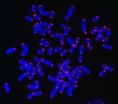"Having an enlarged prostate is very common in many men over the age of 50, and these new findings provide hope for those who might not be candidates for transurethral resection of the prostate, or TURP—and may allow them to avoid serious complications that sometime result from surgery, such as impotence, retrograde ejaculation and urinary incontinence. This could mean that more men have a chance at getting their lives back," said Francisco Cesar Carnevale, M.D. Ph.D., professor and chief of the interventional radiology section at the Hospital das Clínicas Hospital of the Faculty of Medicine at the University of São Paulo in Brazil.
A man's prostate can slowly grow larger with age due to a noncancerous process called benign prostatic hyperplasia, or BPH. In many men this enlargement can compress the urethra and cause urination and bladder problems such as dribbling at the end of urinating, an inability to urinate, incomplete emptying of the bladder, incontinence, and having a strong and sudden urge to urinate or a weak urine stream. For these men, symptoms can cause a marked decrease in quality of life, said Carnevale.
"More than a quarter of a million men undergo surgery for an enlarged prostate every year, at an estimated annual costs of over $1 billion per year because current therapies including medication just aren't working for them," commented Ziv J Haskal, M.D., FSIR, one of numerous Society of Interventional Radiology members who traveled to Brazil to learn about the treatment and to begin the process that may bring this treatment to the United States. "I saw firsthand how these men responded to treatment. With the possibility of faster recovery—on an outpatient basis—and with no bladder catheters, reduced symptoms, improved urination and fewer potential side effects, prostatic artery embolization could signal a bold new change in accepted prostate therapy," added Haskal, a professor of radiology and surgery at the University of Maryland School of Medicine and editor-in-chief of the Journal of Vascular and Interventional Radiology.
"Interventional radiologists have always pioneered the use of minimally invasive treatments for many disease states. Interventional radiologists have used embolization, where a catheter is used to deliver tiny beads to block blood flow to a target area, for many years to treat uterine fibroids, on an outpatient basis, with very few complications. Applying this same principal to the prostate by embolizing or blocking the prostatic arteries, thereby reducing its size and releasing the pressure on the urethra so that a man is then able to void normally, seemed like a natural progression," explained Carnevale.
"This study looked at results from men who suffered with acute urinary retention due to an enlarged prostate and who were treated," noted Carnevale, who indicated that prior to embolization, all had medical treatment and urethral catheters and were waiting for surgery. "After the treatment, we assessed quality of life and evaluated how well the urinary system was working. Clinical success was seen in 91 percent of those treated and technical success was evident in 75 percent of those treated," he added.
Using a tiny one-millimeter diameter microcatheter threaded into the prostate arteries, 12 prostatic artery embolization procedures using resin microspheres as embolizing agents were performed on 11 individuals (ages 59-78 years; average age, 68.5 years) under local anesthesia. Magnetic resonance imaging and ultrasound were also used to study the exact anatomy of the prostate.
Carnevale's subjects had follow-up ranging from 16-45 months. At the time of treatment, the men's prostate size ranged from 30-90 grams (the normal male prostate weighs 20-25 grams); all reported acute urinary retention. Both ultrasound and MRI revealed an overall 30 percent volume reduction in the prostate size at final follow-up. Overall clinical improvement in lower urinary tract symptoms at the one-year mark was observed and corroborated by all patients. All of those treated also reported a high degree of satisfaction and increased quality of life after the treatment.
"Although these preliminary results are very promising for American men, it must be noted that prostate artery embolization is an extremely advanced embolization procedure requiring rigorous training and a detailed knowledge of the prostate anatomy and surrounding vessels," said James B. Spies, M.D., MPH, FSIR, professor and chair of the radiology department at Georgetown University Medical Center in Washington, D.C. "Because interventional radiologists are the leaders in bringing forth new treatments responsibly, I expect there will be considerable additional study, including multicenter clinical trials, that explore the safety, efficacy and durability of this procedure before it will become broadly available in clinical practice. At that stage, the specialty will take the lead on ensuring that practice guidelines are established to ensure appropriate patient care," he added.
###
More information about the Society of Interventional Radiology, interventional radiologists and minimally invasive treatments can be found online at www.SIRweb.org.
Abstract No.3: "Quality of Life and Symptoms Relief Support Prostatic Artery Embolization for Patients With Acute Urinary Retention Due to Benign Prostatic Hyperplasia," F.C. Carnevale, J.M. Motta Leal Filho, A.A. Antunes, L.M.O. Cerri, R.H. Baroni, A.S.Z. Marcelino, G.C. Freire, O.M. Gonçalves, E.M. Yoshinaga, G.G. Cerri, M. Srougi, Departments of Urology, University of São Paulo Medical School, Brazil. SIR 37th Annual Scientific Meeting, March 24-29, 2012. This abstract can be found online at www.JVIR.org and www.SIRmeeting.org.
About the Society of Interventional Radiology
Interventional radiologists are physicians who specialize in minimally invasive, targeted treatments. They offer the most in-depth knowledge of the least invasive treatments available coupled with diagnostic and clinical experience across all specialties. They use X-ray, MRI and other imaging to advance a catheter in the body, such as in an artery, to treat at the source of the disease internally. As the inventors of angioplasty and the catheter-delivered stent, which were first used in the legs to treat peripheral artery disease, interventional radiologists pioneered minimally invasive modern medicine.
Today, interventional oncology is a growing specialty area of interventional radiology. Interventional radiologists can deliver treatments for cancer directly to the tumor without significant side effects or damage to nearby normal tissue.
Many conditions that once required surgery can be treated less invasively by interventional radiologists. Interventional radiology treatments offer less risk, less pain and less recovery time compared to open surgery. Visit www.SIRweb.org.
The Society of Interventional Radiology is holding its 37th Annual Scientific Meeting March 24-29 at Moscone Center, San Francisco, Calif. The theme of the meeting is "IR Evidence," chosen to reflect interventional radiology's gathering, presenting and discussing results of care-changing investigations.
END

